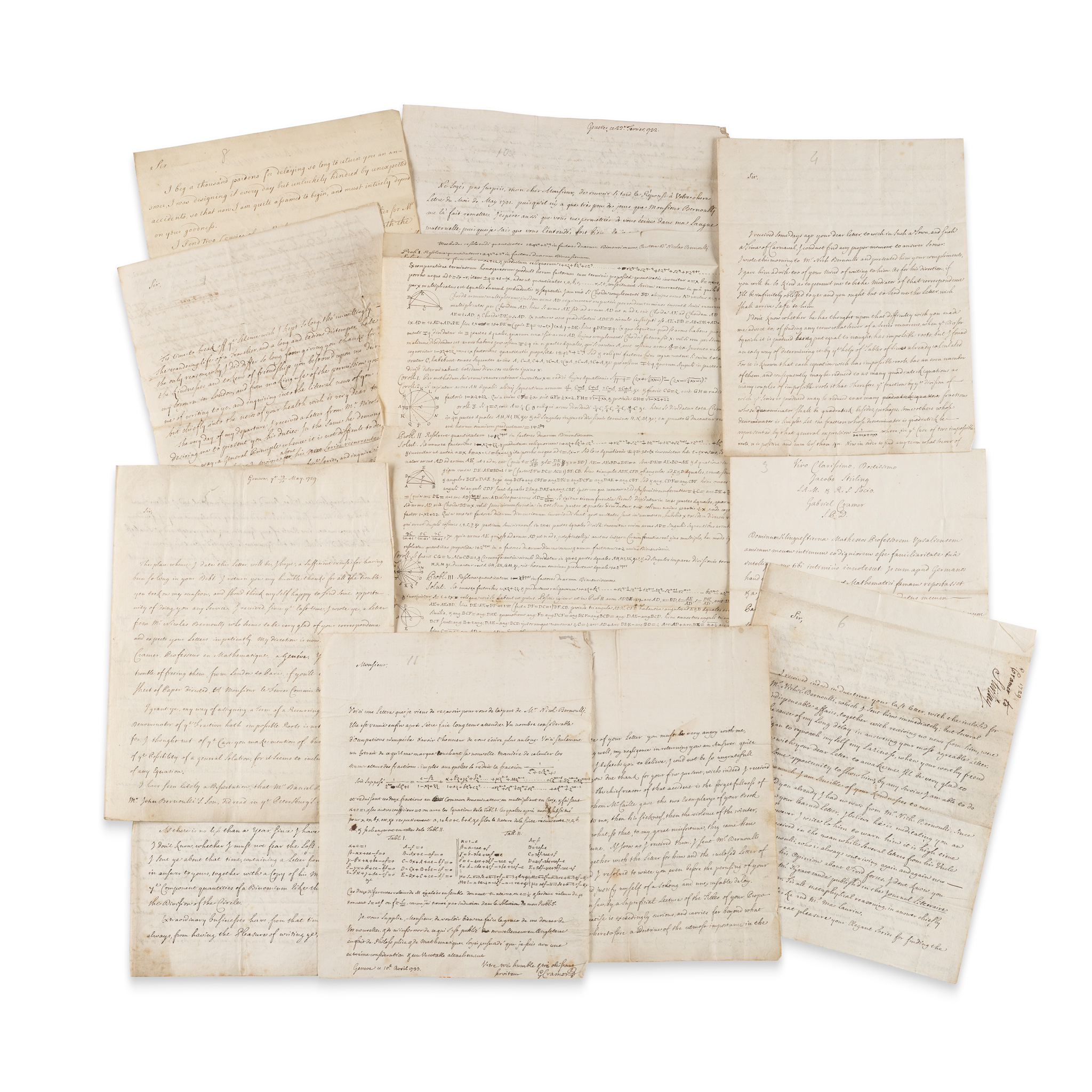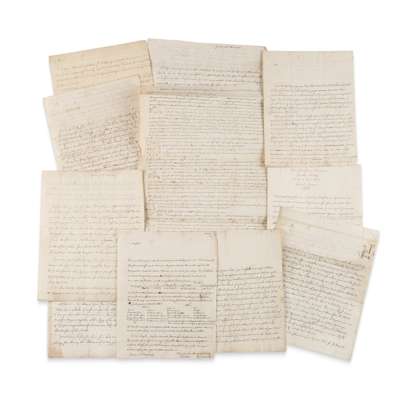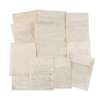
Lot 21

Cramer, Gabriel (1704-1752)
Ten autograph letters signed to James Stirling


The Library of James Stirling, Mathematician
Auction: 23 October 2025 from 13:00 GMT
Description
all sent to James Stirling at Watts’s Academy, Little Tower Street, all in English (except 2 and 3, in Latin, and 9 and 10, in French) and signed ‘G. Cramer’ at foot (except 3, signed ‘Gabriel Cramer’ at head as part of salutation).
1) Paris, 11th/22nd October, 1728, signed G. Cramer, thanking Stirling for his kindness during his stay in London, discussing a letter from Nicolaus Bernoulli on ‘a general principle whence it is not difficult to derive all ye propositions about his series recurrentes’, and continuing, ‘Mr ‘S Gravesande, who is wholly employ’d about ye doctrine of forces, did communicate me the following construction for the laws of percussion … Is there nothing under the press of Sr Isaac’s remains? … Can we flatter ourselves of the hopes [sic] of seeing very soon your learned work about ye Series’, with a diagram, 3 pp., 23 x 18cm, losses and separation along central fold not affecting text;
2) Geneva, 6th January 1729, signed G. Cramer, comprising a brief autograph covering note by Cramer, the remainder of the letter being an apparently secretarial copy of a letter in Latin from Nicolaus Bernoulli showing ‘his method of resolving ye quantity 1 / 1±qzⁿ+zⁿ2 in its component fractions’ (headed ‘Methodus resolvendi quantitates 1 / 1±qzⁿ+zⁿ2 in factores duarum dimensionum’), with 5 diagrams, 2 pp., 38.5 x 25.5cm, a little loss to one edge affecting a few words;
3) Geneva, 20th June 1729, addressed and signed at head ‘Viro Clarissimo Doctissimo Jacobo Stirling L.A.M. & R.S. Socio Gabriel Cramer J.B.D’, a letter recommending Swedish mathematician Samuel Klingenstierna, 1 p., 21.5 x 17cm;
4) Paris, 12th March 1729, offering to act as the ‘mediator’ of Stirling’s correspondence with Nicolaus Bernoulli, providing a solution using sine tables for ‘finding any term whatsoever of a series recurrens when the divisor by wich it is produc’d being put equal to naught has impossible roots’, and requesting copies of ‘Mr Maclaurin’s book about vivid forces’ and ‘an account of a letter wich Dr Halley wrote, about twenty years ago to Mr Maraldy in answer to a discourse … against the commonly received opinion of the propagation of light’, 3 pp., 22 x 16.5cm, small seal tear affecting one word;
5) Geneva, 19th/30th May 1729, on recurring series (‘I grant ye, my way of assigning a term of a recurring series, when the denominator of the fraction hath impossible roots is not general enough … I have seen lately a dissertation that Mr Daniel Bernoulli, Mr John Bernoulli’s son, did read in the Petersburg’s Academy concerning the recurring series …’) and an important discovery by James Bradley (‘It seems wondrous now that those who made some attempts to determine the parallel of the fixt stars took no notice of the successive propagation of the light’), with a lengthy demonstration of a ‘noble theorem’ regarding series, 3 pp., 24 x 19cm, small seal tear just touching one word;
6) Geneva, 26th December 1729, providing a lengthy demonstration of ‘Daniel Bernoulli’s ‘way of approximating to the greatest and smallest root of any given equation by the help of a recurrent series’, and thanking Stirling ‘for the account you gave Mr Bernoulli of Mr Machin’s Theorems [which] seem indeed very well contrived for clearing Sr Isaac Newton’s theory of the motion of the moon’, 24 x 18.5cm;
7) Geneva, 22nd October 1730, demonstrating a correction to ‘S Gravesande’s ‘little improvement to your method, given in your book Enumeration linearum 3ii ordinis’, and enquiring about ‘the Philosophical and Mathematical news of which there is abundance in England in anytimes’, the publication of Stirling’s and de Moivre’s books, and Stirling’s receipt of a letter from Nicolaus Bernoulli on ‘finding the component quantities of a binomium like this 1±zn’, 3 pp., 22 x 17cm, small seal tear affecting a few letters;
8) Geneva, 18th June 1731, explaining his delayed receipt of a presentation copy of Stirling’s book (i.e. Methodus differentialis), reporting Nicolaus Bernoulli’s appointment as professor of civil law at Basel, and addressing in detail (with demonstrations) Stirling’s objections to Bernoulli’s interpolation of a given series, 3 pp., 21.6 x 17cm, seal tear affecting two words, a few small marginal damp-stains;
9) Geneva, 22nd February 1732, a highly detailed letter praising the Methodus differentialis and providing an extensive commentary with demonstrations on subjects including [Brook] Taylor’s rule for finding the form of a series (‘la regle du Dr Taylor pour trouver la forme d’une serie’), presumably Taylor’s theorem, modifications to Taylor’s rule as proposed by Stirling and S’Gravesande, Newton’s parallelogram, and more, with 2 diagrams, 4 pp., 34 x 22.5cm;
10) Geneva, 10th [?]April 1733, providing an example of ‘the new manner of calculating the numerators of simple fractions to which the fraction 1/z2n+2lzn+1 can be reduced’, 1 p., 23 x 17.5cm, a little loss to intersection of one fold.
Together with a contemporary copy of James Stirling’s letter to Cramer, London, September 1730, possibly in Stirling’s own hand, sending copies of his book (Methodus differentialis) to Bernoulli and Cramer, summarising the contents, apologising for errors in the second part (‘The first part has been written 8 or 9 years ago, so that if I were to write it again I should scarce change anything in it. But indeed that is more than I can say for the second part, because there was not above one half of it finished when the beginning of it was sent to the printer’, mentioning de Moivre’s amendment of the 20th proposition concerning logarithms (the solution left blank)
Footnote
Gabriel Cramer was joint professor of mathematics at Geneva’s Académie de Clavin and is best remembered for his 1750 work Introduction à l’analyse des lignes courbes algébriques, which introduced what is now known as Cramer’s Rule. In 1727 he travelled to Basel, where he spent six months with the Bernoulli circle before continuing to London, where he met James Stirling and Abraham de Moivre and was received by the Royal Society. He edited the collected works of Johann I Bernoulli and Jacob I Bernoulli, and, as these letters demonstrate, served as intermediary in Stirling’s correspondence with Nicolaus Bernoulli. Tweedie draws special attention to Cramer’s letter of 22 February 1723 and his ‘difficulties with the graph of yx=1+x; also his determination of (1+x)1/x as x tends close to zero’ (p. 203). He also cites the copy of Stirling’s letter of 1730 as evidence of his priority over de Moivre in the discovery of his eponymous series, and as a source of ‘valuable information regarding the manner in which Stirling wrote his Methodus Differentialis’ (p. 202).
Published:
Charles Tweedie, James Stirling: a Sketch of his Life and Works along with his Scientific Correspondence, 1922, pp. 95-130.

